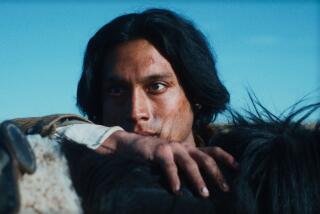MOVIE REVIEW : Poet and Peasants of the ‘Old World’
- Share via
Czech filmmaker Dusan Hanak’s “Pictures of the Old World” (the Nuart for one week only) is so astonishing in its beauty and power it seems safe to say that as a depiction of what it is like to be old it is very nearly unique.
Instead of sentimentality or special pleading, Hanak celebrates the sustaining power of nature as he acquaints us with a number of elderly peasants in the Carpathian Mountains. All of them apparently live alone, most of them maintain livestock and each is a formidable example of self-reliance. They are poor people, their lives largely untouched by modern conveniences, but they draw strength from being firmly rooted in their world.
It is a place of unspoiled scenic grandeur, captured in some of the most ravishing high-contrast black-and-white compositions imaginable; where some filmmakers would find only squalor and hardship Hanak finds beauty and dignity. His camera captures the textures and shapes of farm implements as rough-hewn as the faces of his subjects.
There is a strong folkloric quality to the film in its music, crafts and some of the stories its people tell. A great many of the objects on view, including the enchanting and whimsical mechanical wood sculptures created by one of the film’s interviewees, would be set pieces as “primitives” in any pricey boutique. Yet Hanak is not interested in cataloguing the quaint but rather in showing us how every detail of the environment, natural and man-made, expresses the ingenuity and sturdy simplicity of character of his people, individuals who in most movies would be extras providing local color.
“Pictures of the Old World” is far from being so many talking heads. Hanak’s visits with his subjects are framed with vignettes that connect them with the communal life of their nearby villages. And when Hanak wants to create a sense of discreet distance or an aura of special poignance he resorts to a montage of stills. Each of his people emerges as an individual with his or her own interests and views, but as a group they are proud, uncomplaining and accepting of their lot. Not all of them can answer Hanak’s question as to what is most important or valuable in life--good health is the most frequent reply.
The most striking of these people is the man who had his legs crushed when a farm wagon fell on him 25 years earlier, yet he continues to farm on his hands and knees and has even managed to build himself a house. “You gotta manage,” he shrugs.
Similarly, another man continues to play his bass viol while lying flat on his back. One of the film’s few women, the last of a family of 14, gives meaning to her life by tending to the local cemetery and creating wonderful floral displays for each grave. She is one of several individuals sustained by religious faith whereas a number of men confess to the occasional drowning of sorrows in the bottle.
Although “Pictures of the Old World” is a film about life, exultant more often than depressing, it inevitably must deal with death, and Hanak waits till its final moments to treat of it and its aching loss with the utmost tenderness and discretion.
Almost as astonishing as “Pictures of the Old World” (Times-rated Family), which raises the documentary to the level of poetry, is the revelation that it was banned for 16 years, apparently because its subjects could be regarded as having been neglected by the government. In any event, it is a bleak irony that so perfect a film was suppressed for showing a “flawed” society.
More to Read
Only good movies
Get the Indie Focus newsletter, Mark Olsen's weekly guide to the world of cinema.
You may occasionally receive promotional content from the Los Angeles Times.










